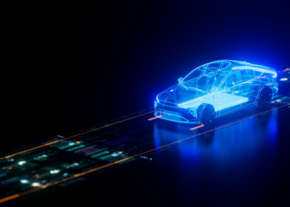
Electrification, automotive’s latest key word
Simonluca Pini – Contributor Editor deIl Sole 24 Ore
The course towards a true zero-emission mobility is set, however time is needed along with a more widespread knowledge of the difference between hybrid and full-electric systems.
Farewell to diesel, as heat engines are slowly abandoned, replaced by an electric-vehicles-only mobility and a dense network of high-performance charging stations. This description is nothing short of science fiction at the moment, even though the course towards electric mobility has been set by the world’s top car makers, partly due to the attack on diesel engines by the authorities despite the most recent efficient and eco-friendly diesel models. Electrification, though, implies also the need to make a clear distinction between the technologies involved, before being able to imagine a world of silent, “engineless” vehicles.
According to a recent study carried out by Pwc, in 2030 electric cars will make up 44% of the European market, 20% in the United States and about 50% in China, confirming the Asian country's desire to become the first e-Mobility market. Going back to EVs, several car manufacturers have announced their intention to exclusively promote and sell electric vehicles in the coming years. This statement may suggest a farewell to heat engines but, on the contrary, it may simply means that we can expect a long series of hybrid systems with different technologies and features along with just a few full-electric models. Going by order, Mhev (Mild-hybrid electric vehicle) systems are the gateway to electrification. Known also as light-hybrid systems, these will contribute to the exponential growth of hybrid vehicles on the market. The reason being their smaller size and lesser complexity compared to traditional hybrid systems, all to the benefit of the final purchase price. Mild-hybrid vehicles are equipped with a parallel electric system, powered by 12 or 28 volt batteries that works together with a small electric motor. Capable of recovering energy when braking, the Mhev system is not really able to move the car on its own, but supplies energy during acceleration thus reducing fuel consumption and hazardous emissions. Despite these characteristics, Mhev cars are in most cases approved as hybrids and take full advantage of provisions such as access to restricted traffic areas and car tax exemptions in certain regions.
The second step includes Hev (Hybrid electric vehicle) models, where an electric motor works together with the internal combustion engine (Ice) and is able to travel as a full-electric vehicle for a few kilometres pressing the EV button on the dashboard. In this case, the electric motor makes a greater contribution in reducing fuel consumption and emissions when compared to Mhev systems, but takes up more space and results in higher costs and weight. The batteries are recharged by the Energy-recovery systems as well as the car’s ICE, as there are no AC plugs and sockets able to connect to a charging stations. If plug-in models is what we are looking for, then it is necessary to switch to Phev (Plug-in hybrid electric vehicle) cars, where an electric motor can be recharged even with the power socket and the zero-emission range rises to about 50 kilometres. Here we are looking at a higher degree of electrification and, you guessed it, higher purchase costs. Nevertheless, in 2019 several dozen Phev models are expected to hit the streets.
The acronym Bev (Battery electric vehicle) identify vehicles without an ICE, powered by an electric motor and rechargeable through AC plugs or Energy-recovery systems. Furthermore, we cannot neglect mentioning also Erev (Extended-range electric vehicles) cars, equipped with a small internal combustion engine used exclusively as a generator when the battery levels are low. Last but not least Fcev (Fuel-cell-electric vehicles) boast hydrogen powered fuel cell batteries. Besides no harmful emissions, these offer greater mileage than other electric models, but the rather limited distribution network is acting as an obstacle to their commercial success though fuelling stations are expected to rise to 1,306 in 2022 and 4,808 in 2032.
According to a recent study carried out by Pwc, in 2030 electric cars will make up 44% of the European market, 20% in the United States and about 50% in China, confirming the Asian country's desire to become the first e-Mobility market. Going back to EVs, several car manufacturers have announced their intention to exclusively promote and sell electric vehicles in the coming years. This statement may suggest a farewell to heat engines but, on the contrary, it may simply means that we can expect a long series of hybrid systems with different technologies and features along with just a few full-electric models. Going by order, Mhev (Mild-hybrid electric vehicle) systems are the gateway to electrification. Known also as light-hybrid systems, these will contribute to the exponential growth of hybrid vehicles on the market. The reason being their smaller size and lesser complexity compared to traditional hybrid systems, all to the benefit of the final purchase price. Mild-hybrid vehicles are equipped with a parallel electric system, powered by 12 or 28 volt batteries that works together with a small electric motor. Capable of recovering energy when braking, the Mhev system is not really able to move the car on its own, but supplies energy during acceleration thus reducing fuel consumption and hazardous emissions. Despite these characteristics, Mhev cars are in most cases approved as hybrids and take full advantage of provisions such as access to restricted traffic areas and car tax exemptions in certain regions.
The second step includes Hev (Hybrid electric vehicle) models, where an electric motor works together with the internal combustion engine (Ice) and is able to travel as a full-electric vehicle for a few kilometres pressing the EV button on the dashboard. In this case, the electric motor makes a greater contribution in reducing fuel consumption and emissions when compared to Mhev systems, but takes up more space and results in higher costs and weight. The batteries are recharged by the Energy-recovery systems as well as the car’s ICE, as there are no AC plugs and sockets able to connect to a charging stations. If plug-in models is what we are looking for, then it is necessary to switch to Phev (Plug-in hybrid electric vehicle) cars, where an electric motor can be recharged even with the power socket and the zero-emission range rises to about 50 kilometres. Here we are looking at a higher degree of electrification and, you guessed it, higher purchase costs. Nevertheless, in 2019 several dozen Phev models are expected to hit the streets.
The acronym Bev (Battery electric vehicle) identify vehicles without an ICE, powered by an electric motor and rechargeable through AC plugs or Energy-recovery systems. Furthermore, we cannot neglect mentioning also Erev (Extended-range electric vehicles) cars, equipped with a small internal combustion engine used exclusively as a generator when the battery levels are low. Last but not least Fcev (Fuel-cell-electric vehicles) boast hydrogen powered fuel cell batteries. Besides no harmful emissions, these offer greater mileage than other electric models, but the rather limited distribution network is acting as an obstacle to their commercial success though fuelling stations are expected to rise to 1,306 in 2022 and 4,808 in 2032.
On the same topic
#Battery Packs, experience and know-how vital in case of fire#Electric Cars, success follows correct battery disposal and recycling
























